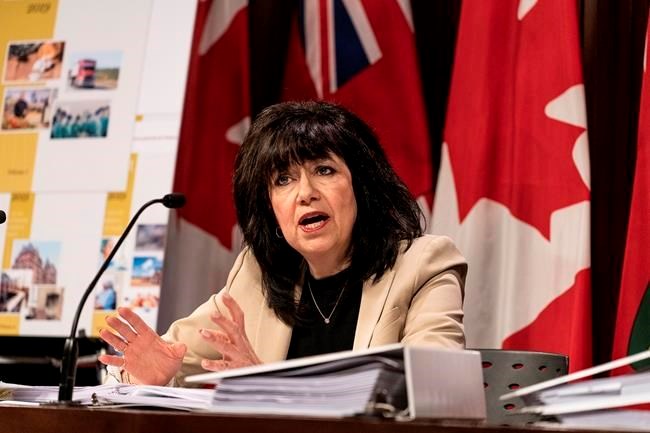TORONTO — Ontario's expansion of virtual health-care services has been too slow, its retirement homes have an increasing number of residents who should be in long-term care, and its gaming, alcohol and cannabis regulator lacks transparency, the province's auditor general said in a sweeping new report released Monday.
Bonnie Lysyk issued 13 value-for-money audits in her annual report, which also looked at consumer protection in the bereavement sector, the review and implementation of school curricula, and other issues.
Lysyk found Ontario has been slow to integrate virtual care services with its health-care system, and while the government relaxed rules around billing for remote care this year to accommodate the surge in demand, that work will need to accelerate after the pandemic.
The auditor found the Ontario Telemedicine Network, which offers remote care, and the Ministry of Health "do not have effective systems and procedures in place to offer virtual care services more long term in a cost-efficient manner to meet Ontarians’ needs."
What's more, she said, the audit found "numerous cases" where physicians had "significantly high" billings for virtual care, including one where a doctor billed $1.7 million for remote services in 2019-2020 and another $1.9 million for in-person services. That doctor reported seeing as many as 321 patients virtually in one day, the report said.
Lysyk also raised concerns about the proliferation of private, for-pay virtual care services, saying they have "created risk of unequal access to health care, as well as oversight risk" since they are not under provincial purview.
The report also delves into the management and operation of Ontario's 770 retirement homes, and found an increasing number of people in those facilities require a higher level of care that could more suitably be provided in a long-term care facility.
More than 4,000 patients who no longer needed acute care in hospitals were discharged to retirement homes in 2019-2020, the auditor found. "Many of those people had health profiles similar to residents in long-term-care homes," Lysyk said.
In another audit, her office found that consumers are not adequately protected from high pressure sales tactics when purchasing funeral services and are often not provided with key pricing information.
An audit of the Bereavement Authority of Ontario found the agency must do a better job requiring the industry to provide pricing transparency to the public.
Key information such as price lists for funeral services and products are not easily accessible to the public, making it difficult for people to comparison shop at a time when they must make decisions quickly and under emotional duress, Lysyk said.
In another audit, Ontario's blood supply was found to be safe and largely reliable, but there were issues surrounding the supply of blood plasma, which largely comes from international sources. Blood plasma is used to produce immunoglobins, a blood product with growing demand, the report said.
Ontario's hospitals obtain blood components and products from the not-for-profit organization Canada Blood Services, but the Ministry of Health does not gather key information about demand for those components or what's used by hospitals, the report said.
“The collection of this information from hospitals would help better forecast future supply needs, which is particularly important given the delays in surgeries as a result of COVID-19,” Lysyk said.
In examining the education sector, the auditor found school curricula in Ontario are aging, with many not being revised in a decade or more. Many textbooks are just as old and "not relevant," she said.
Lysyk said the Ministry of Education does not have a formal process to determine what should be updated and when.
While in most cases, the ministry followed appropriate steps in reviewing, revising and developing curricula, "recent curricula were released without sufficient time for school boards and schools to review them and for teachers to prepare instructional materials and resources to properly implement them."
The auditor also flagged a lack of transparency in the gaming, alcohol and cannabis regulator.
Lysyk conducted her first audit of the Alcohol and Gaming Commission of Ontario and was critical of how it oversees its approximately 78,500 licensees across the four sectors it regulates.
She noted that compliance officials have “significant autonomy” when it comes to selecting establishments to inspect, but do not document the rationale used to make the selection.
Lysyk also noted that most recreational cannabis sold in the province continues to be sold illegally – accounting for almost 80 per cent of sales in 2019-2020.
Meanwhile, the agency is not monitoring the movement of recreational cannabis in retail stores, she said. The report found stores reported destroying nearly 5,500 units of product from September 2019 to July 2020. But the AGCO had no assurance that these units were “not lost, stolen, or diverted.”
The agency itself also doesn't produce audited financial statements – the only regulatory government agency to not publish such information, the report said.
Lysyk also highlighted a lack of co-ordination when it comes to services for Indigenous communities and people, saying even the Ministry of Indigenous Affairs was "not familiar" with many of the programs offered.
She also pointed to limited access to broadband internet as a barrier for Indigenous communities when it comes to using services like virtual health care, online learning and e-commerce opportunities. Only 17 per cent of households on First Nations reserves have basic internet service, Lysyk said.
The auditor said the Premier Doug Ford’s government also spent over $37.5 million on advertising this year, up from approximately $16 million the previous year.
Lysyk said her office had “concerns” with 125 ads in four campaigns - nearly 20 per cent of the government’s advertising in 2019-2020 - with a value of nearly $9.5 million.
Those ads would not have passed more stringent rules barring partisan or self-congratulatory messages that were scrapped by the previous government in 2015, she said.
This report by The Canadian Press was first published Dec. 7, 2020.
Shawn Jeffords and Paola Loriggio, The Canadian Press
